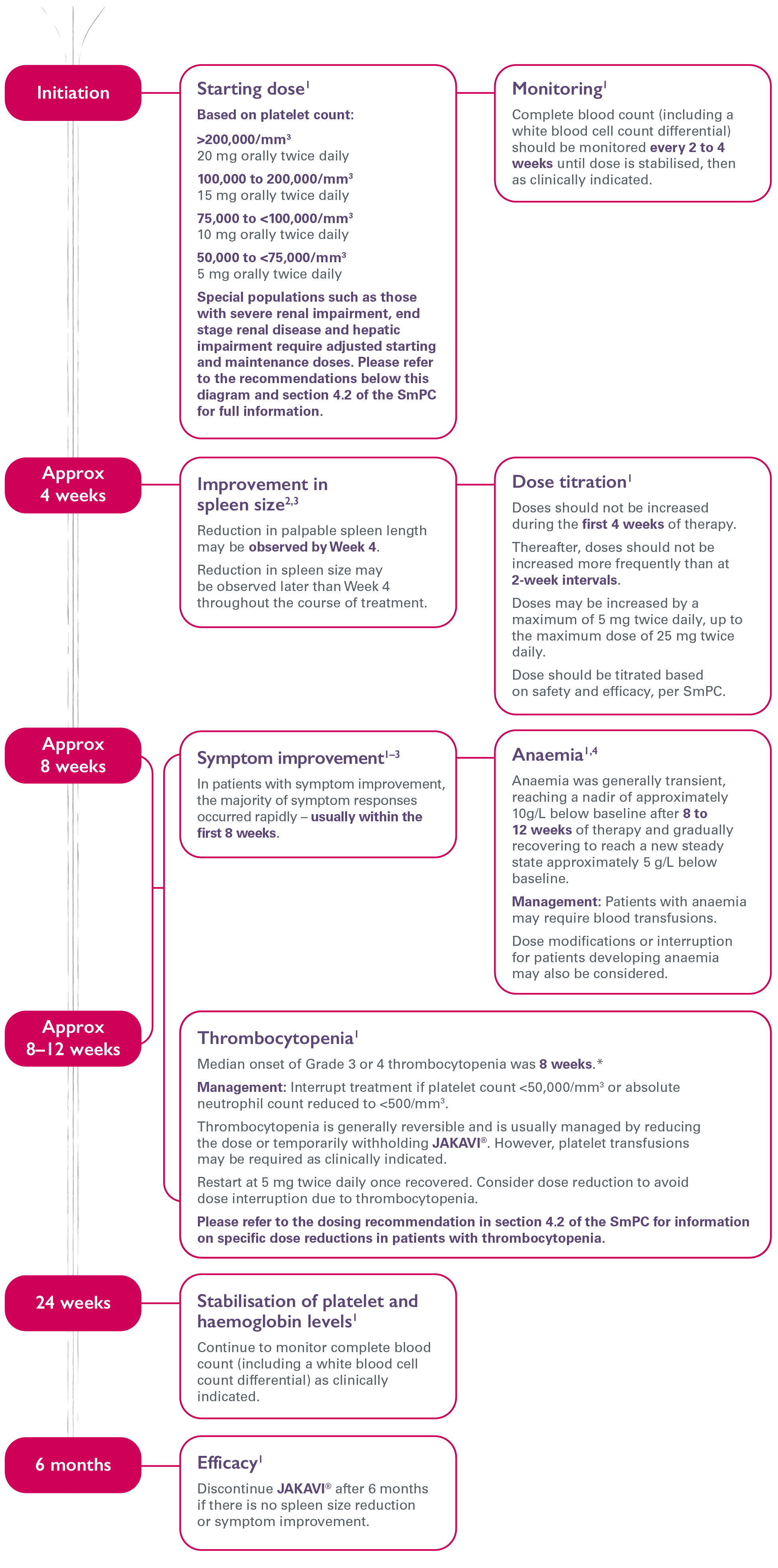

Dose optimisation
JAKAVI® (ruxolitinib) is indicated for the treatment of disease-related splenomegaly or symptoms in adult patients with primary myelofibrosis (also known as chronic idiopathic myelofibrosis), post polycythaemia vera myelofibrosis or post essential thrombocythaemia myelofibrosis. JAKAVI® is also indicated for adult patients with polycythaemia vera who are resistant to or intolerant of hydroxyurea.1
JAKAVI® is available in four tablet strengths to enable dose optimisation for each patient1

The recommended starting dose for JAKAVI® in myelofibrosis is based on a patient’s platelet count at treatment initiation.1
5 mg twice daily for patients with a platelet count between 50,000/mm3 and <75,000/mm3
10 mg twice daily for patients with a platelet count between 75,000/mm3 and <100,000/mm3
15 mg twice daily for patients with a platelet count between 100,000/mm3 and 200,000/mm3
20 mg twice daily for patients with a platelet count of >200,000/mm3
The recommended starting dose of JAKAVI® in polycythaemia vera (PV) is 10 mg given orally twice daily.1 For more information about JAKAVI® in PV, click here.
Optimise your patients’ response to therapy with dose titration that’s based on efficacy and safety data1
JAKAVI® treatment should only be initiated by a physician experienced in the administration of anti-cancer medicinal products. A complete blood cell count, including a white blood cell count differential, must be performed before initiating therapy with JAKAVI®.
For further information, please refer to the SmPC.

Dosing in special populations
No specific dose adjustment is needed in patients with mild or moderate renal impairment.
In patients with severe renal impairment (creatinine clearance less than 30 ml/min), the recommended starting dose based on platelet count for MF patients should be reduced by approximately 50% to be administered twice daily.
There are limited data to determine the best dosing options for patients with end-stage renal disease (ESRD) on haemodialysis. Pharmacokinetic/pharmacodynamic simulations based on available data in this population suggest that the starting dose for MF patients with ESRD on haemodialysis is a single dose of 15-20 mg or two doses of 10 mg given 12 hours apart, to be administered post-dialysis and only on the day of haemodialysis. A single dose of 15 mg is recommended for MF patients with platelet count between 100,000/mm3 and 200,000/mm3. A single dose of 20 mg or two doses of 10 mg given 12 hours apart is recommended for MF patients with platelet count of >200,000/mm3. Subsequent doses (single administration or two doses of 10 mg given 12 hours apart) should be administered only on haemodialysis days following each dialysis session.
In MF patients with any hepatic impairment, the recommended starting dose based on platelet count should be reduced by approximately 50% to be administered twice daily. Subsequent doses should be adjusted based on careful monitoring of safety and efficacy.
If JAKAVI® is to be co-administered with strong CYP3A4 inhibitors in MF and PV patients or dual inhibitors of CYP3A4 and CYP2C9 enzymes (e.g., fluconazole), the unit dose of JAKAVI® should be reduced by approximately 50%, to be administered twice daily (for monitoring frequency, see sections 4.2 and 4.5 of the SmPC).1
Treatment may continue as long as benefit-risk balance remains positive. After interruption or discontinuation of JAKAVI® dosing, symptoms of myelofibrosis may return over a period of approximately 1 week. Unless abrupt discontinuation is required, gradual tapering of the dose may be considered, although the utility of tapering is unproven. Refer to the full Summary of Product Characteristics for further management guidance.1
Please refer to the SmPC for full dosing information before prescribing.
Active monitoring can help you find a patient’s optimal JAKAVI® dose1
Footnotes & references
*For the full list of AEs, please refer to the SmPC.1
AE, adverse event; MF, myelofibrosis; PV, polycythaemia vera; SmPC, summary of product characteristics.
References
JAKAVI® (ruxolitinib) Summary of Product Characteristics.
Polverelli N, et al. EHA 2016, 9–12 June; Copenhagen, Denmark. Abstract P672.
Harrison C, et al. N Engl J Med 2012;366:787–798.
Verstovsek S, et al. Haematologica 2013;98:1865–1871.
Learn more about a generally manageable safety profile for your patients
UK | November 2024 | FA-11210096
Adverse events should be reported. Reporting forms and information can be found at www.mhra.gov.uk/yellowcard. Adverse events should also be reported to Novartis online through the pharmacovigilance intake (PVI) tool at www.novartis.com/report, or alternatively email [email protected] or call 01276 698370.